EQUIPMENT
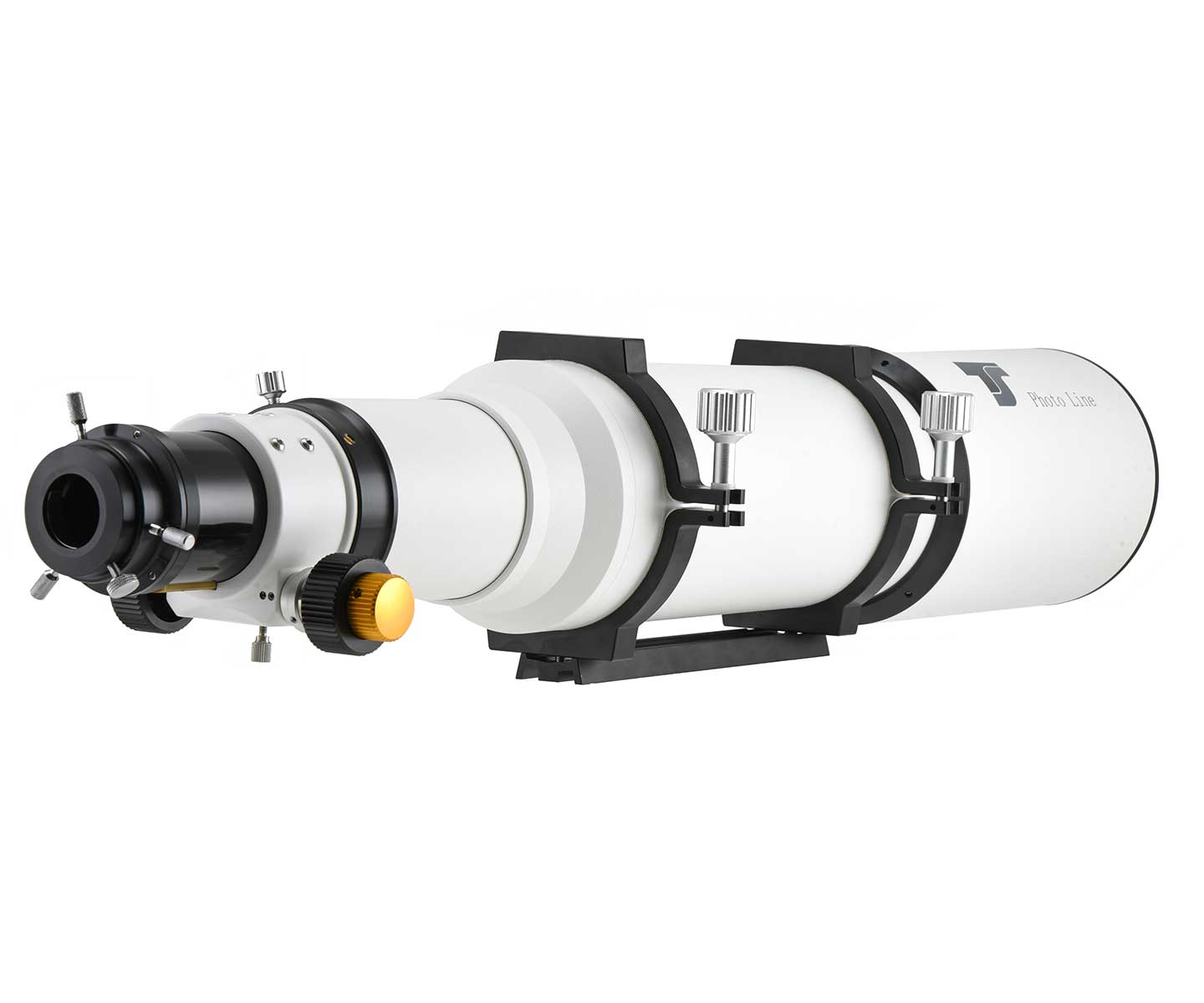
TS-Optics PHOTOLINE 130 mm f/7 FPL53 Triplet APO
Likes:- Very good optics.
- Good bang for the buck.
- Comes with dual-speed rack-and-pinion focuser.
- Good quality throughout.
- No
collimation.
- Heavy front, may require ankle-weight at back for balance.
- Not perfectly free of chromatic aberration.
The front of this scope is heavy due to the high-quality FPL53 glass. To balance, you can either move the scope back in the saddle, or do what I did: Add an ankle-weight just in front of the focuser. That way the scope can remain in the middle of the saddle, which allows the scope to swing further down without the rear hitting the tripod legs.
For field-flattening, I use the AstroTech ATREDT30 as a Focal-Reducer/Field-Flattener. It works well, but for best results you need to carefully fine-tune the spacing to match the scope. For no focal-length reduction, the AstroTech AT2FF Field-Flattener works well and is more forgiving about spacing requirements.
Likes:
- Very good optics.
- Moderately-priced.
- Comes with dual-speed rack-and-pinion focuser.
- Great quality throughout.
- No collimation.
- Light
weight.
- Fine-tuning the spacing of the StellarVue SFFR-70APO Focal-Reducer/Field-Flattener is touchy (as with any short fast refractor).
Likes:
- Active CMOS technology - very good signal/noise ratio.
- Lowest cost solution for LRGB and narrowband imaging.
- Filter quality is surprising good.
- Modern
amenities - light weight, reliable, TEC cooling, fast download.
- CMOS noise requires different technique than CCD (higher gain, shorter exposures)
- Sensor size is a little small for my liking.
- Cross-pattern on bright stars caused by micro-lens effect is a little annoying.
- Not
latest technology - The new Sony IMX sensors offer noticeable
improvement.
The "Pro" version has none of these problems - It's almost like a different camera. The key to using these cameras is to set the gain high, take short exposures, and stack a lot of subs. Then you'll see that an hour of data from this camera is better than an hour of data from a typical CCD camera.
Some people are bothered by the cross-pattern that appears on very bright stars due to the micro-lens effect. But it's subtle - I didn't even notice it until after I read about it. Some people also say the filters have problems, including reflections. To me they work fine, but then I haven't tried any other filters, so maybe I just don't know what I'm missing.
Altogether, I'm quite pleased with this camera, and would only upgrade because the technology has moved ahead ... again.
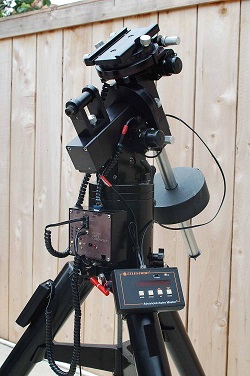 Celestron
CI-700 Mount
Celestron
CI-700 MountThis is a heavy-duty GEM that used to be produced by Celestron to support their C-11 and C-14 SCTs from 1999 to 2003. It's basically a cheaper version of the Losmandy G-11. Although hard to find, some consider it one of the best bargains in the used mount market. In general I'm very happy with this mount, and it serves well for both observing and imaging.
Likes:
- Low Periodic Error (typically 10-15 arc-sec)
- Very Sturdy
- Smooth Drive Corrections (easy to guide)
- Manual Slow-motion Controls
- Slow Slew Speeds
- Polar-finder is small and non-illuminated
- Clutches may slip and bind
(can be fixed)
I've modified the CI700 to improve the action of the clutches, and to allow for quicker and easier set up. See CI700 Mods.
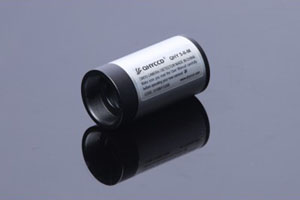 QHYCCD QHY5-IIM Guide Camera:
QHYCCD QHY5-IIM Guide Camera:I was surprised at how easy it is to find guide-stars when this camera is used with an OAG. There was also an immediate improvement in guiding accuracy, probably due to strong
signal/noise ratio that allows more accurate calculation of the star position. Highly recommended!
Likes:
- Very sensitive (QE = 70%), despite being CMOS, 2X2 bin mode = more sensitivity.
- Video, so it can be used for lunar/planetary imaging.
- Small size, light weight.
- Low cost compared to other sensitive guide cameras.
- Long back-focus of 17mm may present problems when trying to reach focus on an OAG, but nose-piece can be removed.
Past Equipment
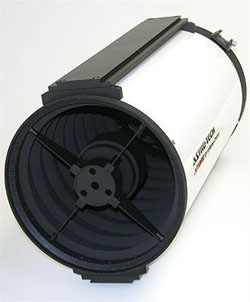
Astro-Tech AT8RC 8" Ritchey-Chretien
Likes:
- Great bang for the buck!
- True Ritchey-Chretien, with no coma or chromatic aberration.
- Capable of superb images with well-shaped stars across the entire image.
- Plenty of back focus accommodates just about any imaging setup.
- Comes with dual-speed focuser.
- Open
front eliminates dew problems.
- Field flattener required, as with all Ritchey-Chretiens.
- Flexure between the primary mirror cell and focuser necessitates use of OAG and requires frequent re-collimation.
- Collimation instructions in manual are not good for imaging.
- Focuser is adequate, but somewhat erratic.
See my page of AT8RC Collimation tips
I eventually sold this scope after getting tired of collimating it, sometimes twice in an imaging session! But since then I've heard that the 10" version has less collimation drift because the focuser is attached directly to the back of the scope instead of the mirror cell.
Likes:
- Good, wide-angle performance for the price.
- No coma, like all refractors.
- Semi-apochromatic with ED (Extra-low Dispersion) glass results in small amount of chromatic aberration.
- Light enough to
double as a guide-scope.
- Not a true apochromatic triplet.
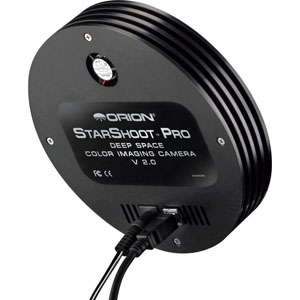
Orion StarShoot Pro V2
Likes:
- Along with the QYH8, perhaps the best bang-for-the-buck for a used CCD one-shot-color camera.
- Real Astro-CCD features: Thermal-electric cooling (TEC) and 16-bit A/D.
- Large pixels results in very good sensitivity.
- IR-cut filter is not aggressive (allows plenty of red).
- Low current draw - 1 amp.
- Proven reliability.
- Large pixels limit resolution when you zoom-in-and-crop.
- TEC is unregulated and limited to 30 deg C. below ambient.
- Download is slow, about 10
seconds.
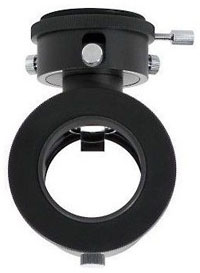
Likes:
- Sturdy, well designed unit.
- 100 degrees rotation without detaching from camera.
- Adjustable tilt pick-off mirror.
- Threaded top of turret rotates
for guide camera focus.
- Comes with plenty of T-thread spacers and 2" front adapter.
- Not a "thin" OAG, adds 30mm to back focus requirement.
For a few years I used the OTA from a Meade 8" LX50 SCT for long focal-length imaging. The optical quality was good, but not great. There is an expected degree of coma at the edge of the field-of-view, and the corrector lens in front presents dew problems. Over time I finally decided to upgrade to a Ritchey-Chretien.
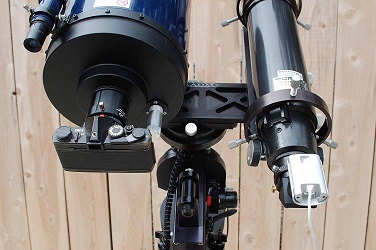 ADM Side-by-side Platform:
ADM Side-by-side Platform:For a few years I mounted the Meade SCT and the ED80 on a side-by-side platform which allowed imaging or guiding through either scope. It's a convenient setup, being able to switch between wide-angle or higher magnification imaging at will. But flexure problems with the new AT8RC forced me to change to an off-axis-guider.
Before that, the ED80 was mounted on the SCT piggy-back style, but sometimes there wasn't enough room to get my head in for finding, framing, or focusing. Switching to a side-by-side platform solved that by allowing plenty of room.
Philips ToUCam Pro 740 Webcam:
Although usable as a guide camera through a guide-scope, it just doesn't have the sensitivity to guide well on anything other than very bright stars. Guiding was sometimes decent, but never great. Don't even think of using it with an OAG. I upgraded to a QHYCCD QHY5-IIM and never looked backed.
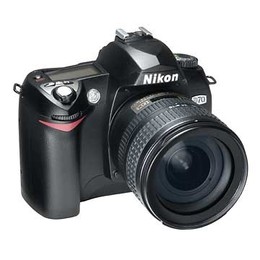 Nikon
D50 DSLR
Nikon
D50 DSLRThe Nikon D50 is a DSLR (digital single lens reflex) camera that uses one of the new generation of full-size format, low-noise high-sensitivity CCD chips. It's similar to the Canon EOS series, except the D50 cannot be controlled by computer software such as Backyard EOS. I had to focus using a par-focal eyepiece, and start/stop exposures using the Nikon remote "clicker". Canons or later model Nikons don't have these problems.
Nikon Infra-red Filter:
All digital cameras have an IR filter because CCD sensors are overly sensitive to red light. The result is that emission nebula lacks that vivid red we love to see, although other objects will image just fine. Removing the IR filter is difficult, but the links page may give you ideas on how to remove it.
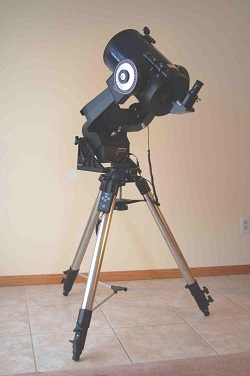 Meade 8"
LX50 SCT
Meade 8"
LX50 SCT My 2nd scope was a Meade 8" LX50. Like most SCTs, it offers a good compromise between quality and cost. Using the same fork-arms as the LX200, it may be the sturdiest mount of any mass-produced fork-arm design. It served well for observing and a limited amount of film-based imaging. Later, I mounted the OTA (optical tube assembly) to a Celestron CI700 mount for better and easier guiding.
Jason Schmidt-Newtonian
My 1st scope was an inexpensive one from a department-store, complete with wobbly tripod. But it presented me those first wonderful sights of the rings of Saturn and the Orion Nebula., and propelled my interest in astronomy. I even used it to take photos of the 1991 Solar Eclipse and comet Hale-Bopp. The camera was mounted on the scope piggy-back, and I used the slow-motion knobs to track. (That's right, slowly turning the R/A knob while looking through the eyepiece!)

